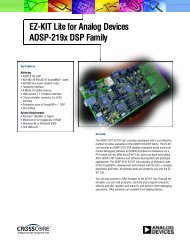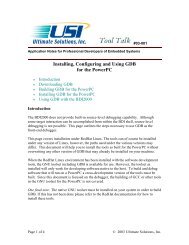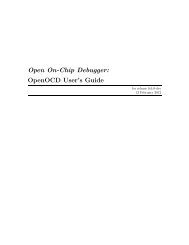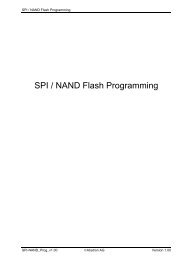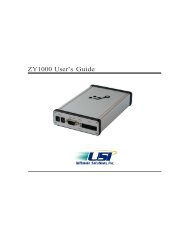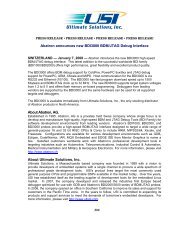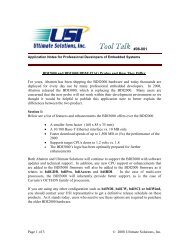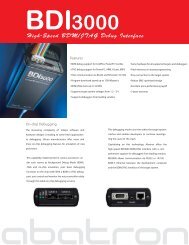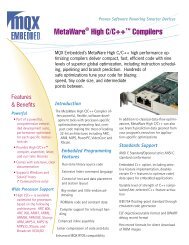P2040 QorIQ Integrated Processor Hardware Specifications
P2040 QorIQ Integrated Processor Hardware Specifications
P2040 QorIQ Integrated Processor Hardware Specifications
You also want an ePaper? Increase the reach of your titles
YUMPU automatically turns print PDFs into web optimized ePapers that Google loves.
<strong>Hardware</strong> Design Considerations<br />
ECn_GTX_CLK125 is a 125-MHz input clock on the dTSEC ports. If the dTSEC ports are not used for RGMII, the<br />
ECn_GTX_CLK125 input can be tied off to GND.<br />
If RCW field I2C = 0b0100 or 0b0101 (RCW bits 354–357), the SDHC_WP and SDHC_CD input signals are enabled for<br />
external use. If SDHC_WP and SDHC_CD are selected and not used, they must be externally pulled low such that<br />
SDHC_WP = 0 (write enabled) and SDHC_CD = 0 (card detected). If RCW field I2C ≠ 0b0100 or 0b0101, thereby selecting<br />
either I2C3 or GPIO functionality, SDHC_WP and SDHC_CD are internally driven such that SDHC_WP = write enabled and<br />
SDHC_CD = card detected and the selected I2C3 or GPIO external pin functionality may be used.<br />
TMP_DETECT pin and LP_TMP DETECT pin are active low input to the Security Monitor (refer to the “Secure Boot and Trust<br />
Architecture” chapter of the chip reference manual). If a tamper sensor is used, it must maintain the signal at the specified<br />
voltage until a tamper is detected. A 1K pulldown resistor strongly recommended. If Trust is used without tamper sensors, tie<br />
high.VDD_LP must be connected even if Low Power features aren’t used. Otherwise, the LP_Section will generate internal<br />
errors that will prevent the high power trust section from reaching Trusted/Secure state. If no aspect of Trust Arch is to be used,<br />
all Trust Arch pins can be tied to GND.<br />
3.6.1 Legacy JTAG Configuration Signals<br />
Correct operation of the JTAG interface requires configuration of a group of system control pins as demonstrated in Figure 55.<br />
Care must be taken to ensure that these pins are maintained at a valid negated state under normal operating conditions as most<br />
have asynchronous behavior and spurious assertion will give unpredictable results.<br />
Boundary-scan testing is enabled through the JTAG interface signals. The TRST signal is optional in the IEEE Std 1149.1<br />
specification, but it is provided on all processors built on Power Architecture technology. The device requires TRST to be<br />
asserted during power-on reset flow to ensure that the JTAG boundary logic does not interfere with normal chip operation.<br />
While the TAP controller can be forced to the reset state using only the TCK and TMS signals, generally systems assert TRST<br />
during the power-on reset flow. Simply tying TRST to PORESET is not practical because the JTAG interface is also used for<br />
accessing the common on-chip processor (COP), which implements the debug interface to the chip.<br />
The COP function of these processors allow a remote computer system (typically, a PC with dedicated hardware and debugging<br />
software) to access and control the internal operations of the processor. The COP interface connects primarily through the JTAG<br />
port of the processor, with some additional status monitoring signals. The COP port requires the ability to independently assert<br />
PORESET or TRST in order to fully control the processor. If the target system has independent reset sources, such as voltage<br />
monitors, watchdog timers, power supply failures, or push-button switches, then the COP reset signals must be merged into<br />
these signals with logic.<br />
The arrangement shown in Figure 55 allows the COP port to independently assert PORESET or TRST, while ensuring that the<br />
target can drive PORESET as well.<br />
The COP interface has a standard header, shown in Figure 54, for connection to the target system, and is based on the 0.025"<br />
square-post, 0.100" centered header assembly (often called a Berg header). The connector typically has pin 14 removed as a<br />
connector key.<br />
The COP header adds many benefits such as breakpoints, watchpoints, register and memory examination/modification, and<br />
other standard debugger features. An inexpensive option can be to leave the COP header unpopulated until needed.<br />
There is no standardized way to number the COP header; so emulator vendors have issued many different pin numbering<br />
schemes. Some COP headers are numbered top-to-bottom then left-to-right, while others use left-to-right then top-to-bottom.<br />
Still others number the pins counter-clockwise from pin 1 (as with an IC). Regardless of the numbering scheme, the signal<br />
placement recommended in Figure 54 is common to all known emulators.<br />
3.6.1.1 Termination of Unused Signals<br />
If the JTAG interface and COP header is not used, Freescale recommends the following connections:<br />
• TRST must be tied to PORESET through a 0 kΩ isolation resistor so that it is asserted when the system reset signal<br />
(PORESET) is asserted, ensuring that the JTAG scan chain is initialized during the power-on reset flow. Freescale<br />
recommends that the COP header be designed into the system as shown in Figure 55. If this is not possible, the<br />
<strong>P2040</strong> <strong>QorIQ</strong> <strong>Integrated</strong> <strong>Processor</strong> <strong>Hardware</strong> <strong>Specifications</strong>, Rev. 0<br />
Freescale Semiconductor 121
<strong>Hardware</strong> Design Considerations<br />
isolation resistor will allow future access to TRST in case a JTAG interface may need to be wired onto the system in<br />
future debug situations.<br />
• No pull-up/pull-down is required for TDI, TMS, or TDO.<br />
COP_TDO<br />
1 2<br />
NC<br />
COP_TDI<br />
3<br />
4<br />
COP_TRST<br />
NC<br />
5<br />
6<br />
COP_VDD_SENSE<br />
COP_TCK<br />
7<br />
8<br />
COP_CHKSTP_IN<br />
COP_TMS<br />
9<br />
10<br />
NC<br />
COP_SRESET<br />
11<br />
12<br />
NC<br />
COP_HRESET<br />
13<br />
KEY<br />
No pin<br />
COP_CHKSTP_OUT<br />
15<br />
16<br />
GND<br />
Figure 54. Legacy COP Connector Physical Pinout<br />
<strong>P2040</strong> <strong>QorIQ</strong> <strong>Integrated</strong> <strong>Processor</strong> <strong>Hardware</strong> <strong>Specifications</strong>, Rev. 0<br />
122<br />
Freescale Semiconductor
<strong>Hardware</strong> Design Considerations<br />
OV DD<br />
From Target<br />
Board Sources<br />
(if any)<br />
HRESET<br />
PORESET<br />
7<br />
10 kΩ<br />
HRESET 6<br />
10 kΩ PORESET 1<br />
13<br />
11<br />
COP_HRESET<br />
COP_SRESET<br />
B<br />
A<br />
10 kΩ<br />
10 kΩ<br />
5<br />
10 kΩ<br />
1 2<br />
3<br />
5<br />
4<br />
6<br />
4<br />
6<br />
5<br />
COP_TRST<br />
COP_VDD_SENSE 2<br />
NC<br />
10 Ω<br />
10 kΩ<br />
TRST 1<br />
7<br />
9<br />
11<br />
13<br />
15<br />
8<br />
10<br />
12<br />
KEY<br />
No pin<br />
16<br />
COP Connector<br />
Physical Pinout<br />
COP Header<br />
COP_CHKSTP_OUT<br />
15<br />
14 3<br />
COP_CHKSTP_IN<br />
8<br />
COP_TMS<br />
9<br />
COP_TDO<br />
1<br />
COP_TDI<br />
3<br />
COP_TCK<br />
7<br />
System logic<br />
10 kΩ<br />
10 kΩ<br />
CKSTP_OUT<br />
TMS<br />
TDO<br />
TDI<br />
TCK<br />
2<br />
NC<br />
10<br />
NC<br />
12<br />
4<br />
16<br />
Notes:<br />
1. The COP port and target board must be able to independently assert PORESET and TRST to the processor<br />
in order to fully control the processor as shown here.<br />
2. Populate this with a 10 Ω resistor for short-circuit/current-limiting protection.<br />
3. The KEY location (pin 14) is not physically present on the COP header.<br />
4. Although pin 12 is defined as a No-Connect, some debug tools may use pin 12 as an additional GND pin for improved<br />
signal integrity.<br />
5.This switch is included as a precaution for BSDL testing. The switch must be closed to position A during BSDL testing<br />
to avoid accidentally asserting the TRST line. If BSDL testing is not being performed, this switch must be closed<br />
to position B.<br />
6. Asserting HRESET causes a hard reset on the device.<br />
7. This is an open-drain gate.<br />
Figure 55. Legacy JTAG Interface Connection<br />
<strong>P2040</strong> <strong>QorIQ</strong> <strong>Integrated</strong> <strong>Processor</strong> <strong>Hardware</strong> <strong>Specifications</strong>, Rev. 0<br />
Freescale Semiconductor 123




